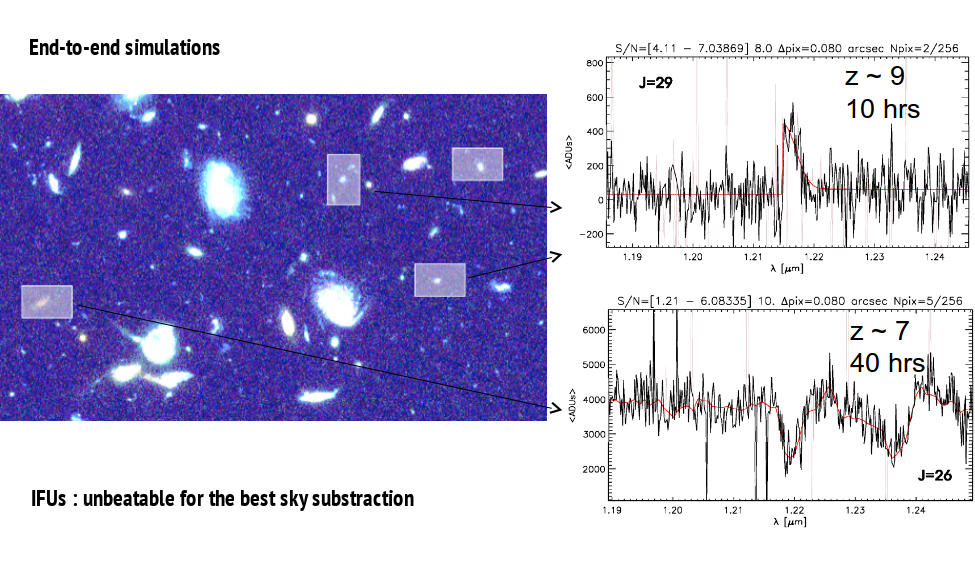|
| ||
During the ESO ELT Design Reference Mission, we developed such an end-to-end simulation pipeline in IDL, which produces fake data in FITS format that mimic the results of real observations. The main steps can be summarized as follows. First, the astrophysical target is modeled as a high-resolution data cube. The two spatial dimensions model the target light distribution at the spatial resolution of the telescope (~λ/2D, where D is the telescope diameter), while the third dimension models how this distribution varies as a function of wavelength. This high-resolution data cube can be constructed from observations of local galaxies or from results of numerical simulations. The second step consists in convolving each spectral and spatial pixel of the high-resolution data cube with a PSF that is representative of the optical path through the atmosphere and the telescope. This PSF, which can include the effect of an AO system if relevant, is simulated using dedicated pipelines. During the third step, the spatial and spectral sampling of the data cube is reduced to match that of the simulated instrument. Specific areas can be extracted depending on the exact observing mode (IFU, slits, or single aperture spectroscopy). Finally, realistic sky background as well as photon and detector noises are added. A full description of the IDL simulation code can be found elsewhere.
During the ELT instruments phase A, this simulation code was coupled to a web interface, which allows any member of an instrument science team to conduct simulations and to provide inputs for the project office to make good design trade-offs. Basic web interfaces, called WEBSIM, were developed and intensively used during the EAGLE and OPTIMOS-EVE Phase A studies. Similar tools were developed by other instrument consortia, such as HSIM for ELT/HARMONI. In the frame of the COMPASS “COMputing Platform for Adaptive optics SystemS” (COMPASS) project , A new web interface called WEBSIM-COMPASS was developed, which now includes a systematic convolution of the spectra by a LSF (defined by a simple Gaussian with FWHM sampled by a number of pixels that is specified by the user, see below), inclusion of the new Paranal advanced sky model (including airglow continuum, emission lines of upper atmosphere, molecular emission of lower atmosphere, and an updated higher resolution absorption curve). The user can also include the effect of Differential Atmospheric Refraction (DAR) in all observing modes.
|
| ||
references :
- Cuby, J.G., Morris, S., Parr-Burman, P., et al., “EAGLE: an MOAO fed multi-IFU working in the NIR on the E-ELT”, Proc. SPIE 7439, 0 (2009)
- Puech, M., Rosati, P., Toft, S., et al., “Specifying an MOAO-fed integral field spectrograph for the E-ELT”, Proc. SPIE 7014, 65 (2008)
- Puech, M., Flores, H., Lehnert, M., et al., “Coupling MOAO with integral field spectroscopy: specifications for the VLT and the E-ELT”, MNRAS 390, 1089 (2008)
- Puech, M., Rosati, P., Toft, S., et al., “Simulating the physics and mass assembly of distant galaxies out to z ~ 6 with the E-ELT”, MNRAS 402, 903 (2010)
- Gratadour, D., et al., “Status update and long term development plan for the COMPASS simulation platform”, Proc. SPIE 9909, in press (2016)
- Navarro, R., Chemla, F., Bonifacio, P., et al., “Project overview of OPTIMOS-EVE: the fibre-fed multi-object spectrograph for the E-ELT”, Proc. SPIE 7735, 2 (2010)
- Puech, M., Yang, Y.B., Flores, H., “Web-based scientific simulation tools for E-ELT instruments”, Proc. SPIE 7735, 5 (2010)
- Zieleniewski, S., Thatte, N., Kendrew, S., et al., “HSIM: a simulation pipeline for the HARMONI integral field spectrograph on the European ELT”, MNRAS 453, 3754 (2015)
- Noll, S., Kausch, W., Barden, M., et al., “An atmospheric radiation model for Cerro Paranal. I. The optical spectral range”, A&A 543, 92 (2012)
- Puech, M.; Yang, Y.; Jégouzo, I., et al., "WEBSIM-COMPASS: a new generation scientific instrument simulator for the E-ELT", Proc. SPIE, 9908,9 (2016)

 The ELT will be the first telescope that entirely depends for routine operations on adaptive optics (AO). In parallel to the telescope Phase B design study, initial instrument Phase A conceptual studies were conducted in 2007-2010. Given the complexity of the telescope and instruments designs, it was also realized that huge parameter spaces had to be explored before educated design choices could be made. To assess the impact of any particular design trade-off directly from the scientific analysis of the expected observations, end-to-end instrument simulation tools that mimic realistic data were required.
The ELT will be the first telescope that entirely depends for routine operations on adaptive optics (AO). In parallel to the telescope Phase B design study, initial instrument Phase A conceptual studies were conducted in 2007-2010. Given the complexity of the telescope and instruments designs, it was also realized that huge parameter spaces had to be explored before educated design choices could be made. To assess the impact of any particular design trade-off directly from the scientific analysis of the expected observations, end-to-end instrument simulation tools that mimic realistic data were required.